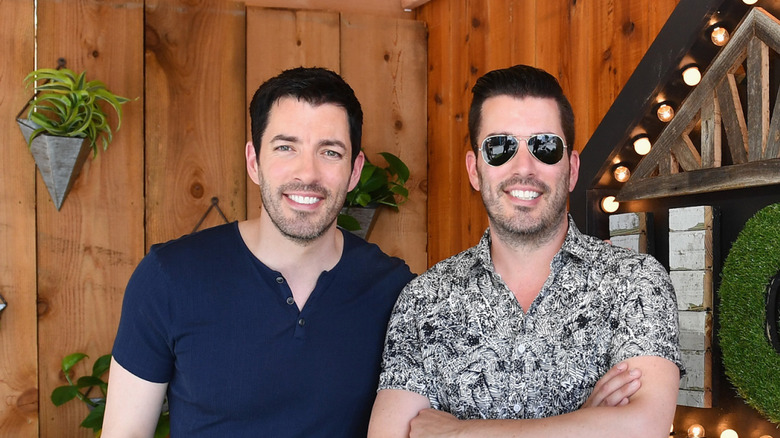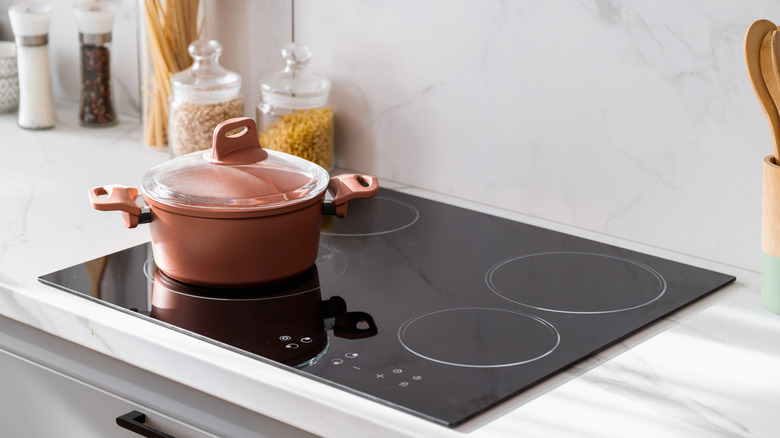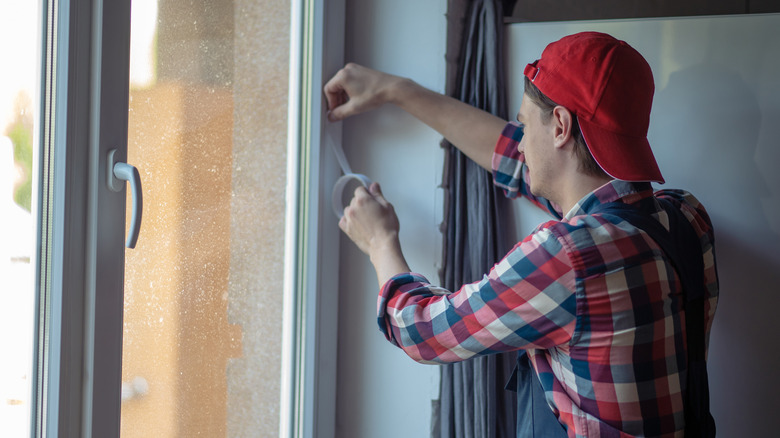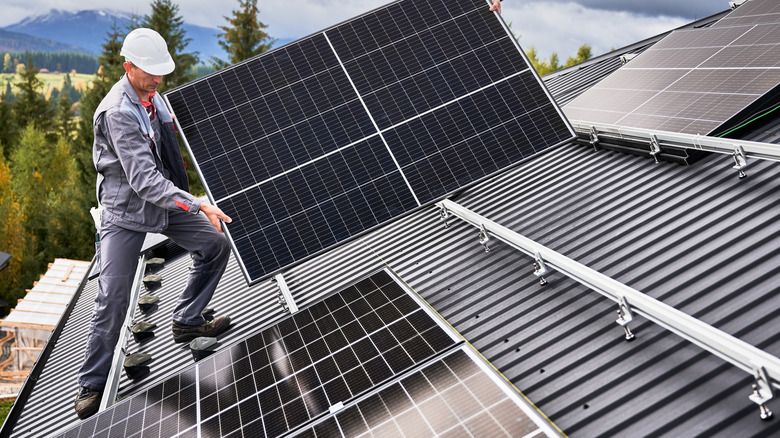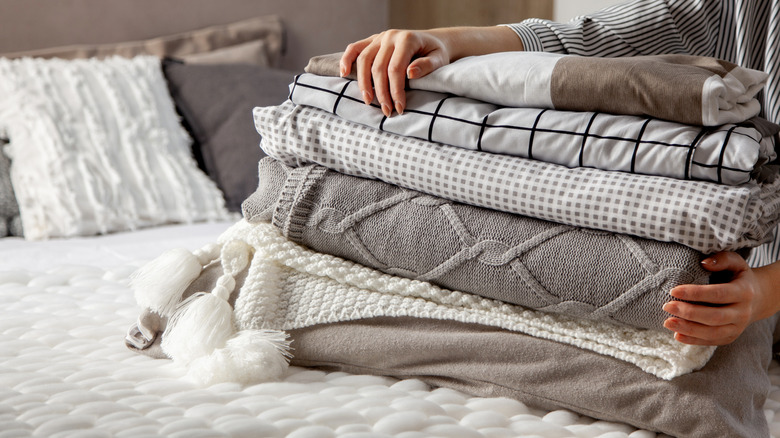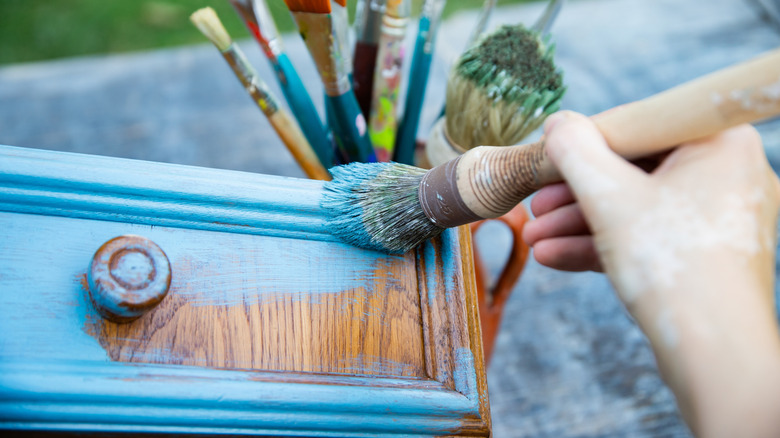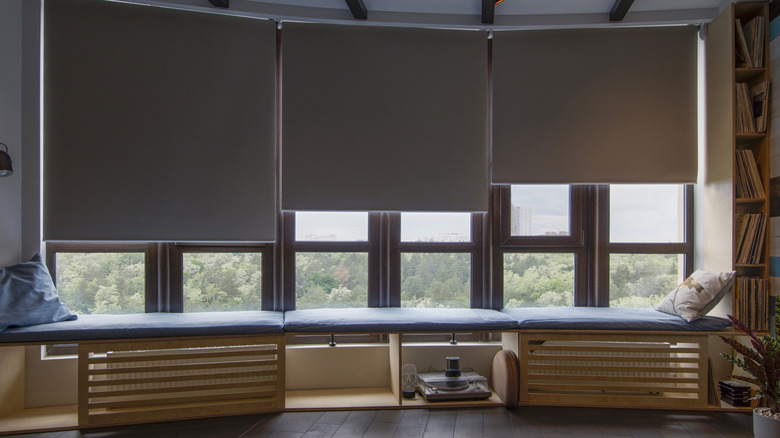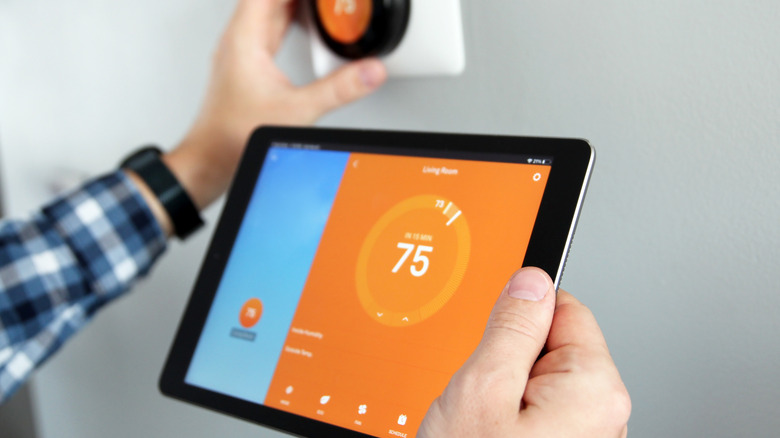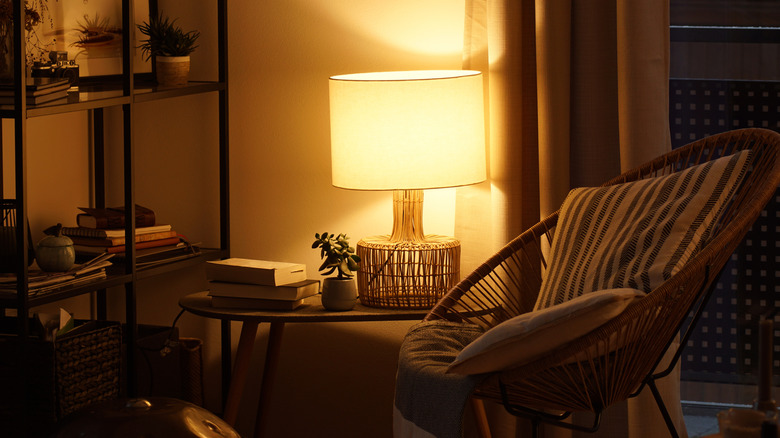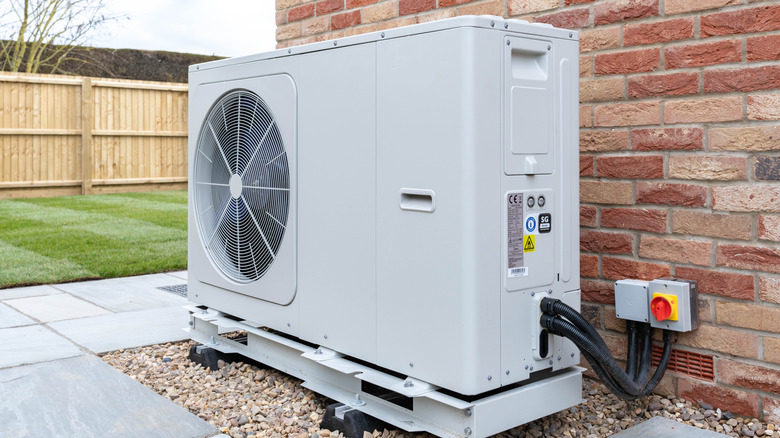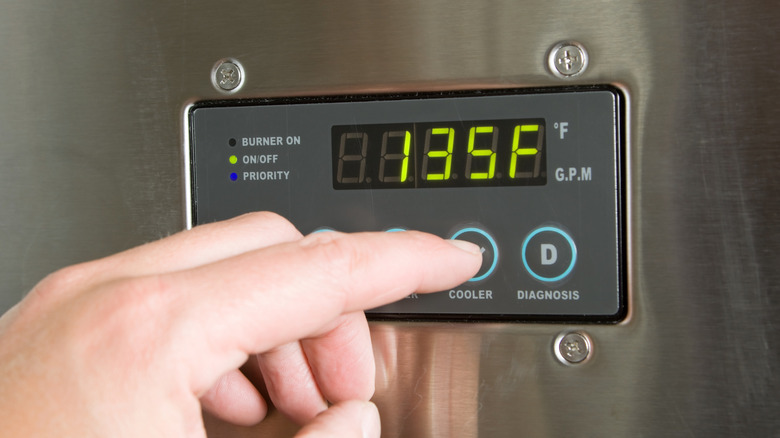The Property Brothers' Best Sustainable Living Tips To Try In Your Home
We may receive a commission on purchases made from links.
HGTV's Jonathan and Drew Scott have been renovating homes for decades.But recently, they seem to be focusing more on how they can help homeowners live more sustainably. The twin brothers are passionate about making changes that can benefit the people living in the home and the environment at the same time. Often, switching to a more sustainable solution will save you money too. For example, layering bedding that you already own in winter instead of cranking up the thermostat won't cost you a dime, and it may just reduce your heating bills.
Drew highlights another benefit in a video on his YouTube channel covering his eco-friendly home tour, "I want to make sure my home is as healthy as possible for my family, and I want to do the same for everybody else out there." In fact, some eco-friendly upgrades can positively impact the health of your family. For example, switching from a gas stove to an induction cooktop can result in cleaner, healthier air.
Since home hacks to improve your climate-friendliness often involve new technology, some homeowners might avoid them, preferring to stick to what they know and understand. Recognizing that sustainability can be an overwhelming topic, Drew tells House Beautiful. "Being so inundated, and so busy with life in general, it's really hard for people to take the time to figure out sustainability." So, we'll explore some easy tips The Property Brothers recommend for creating a more sustainable home and lifestyle.
Replace your gas range for an induction cooktop to save energy and improve air quality
Gas stoves are bad for the air quality in your home, and they're bad for the environment. Research from Environmental Science & Technology revealed that gas stoves leak methane and have a significant impact on climate change. Jonathan explains to House Beautiful, "The scariest reports have finally come out about indoor air quality and gas ranges. No one ever turns their hood on. They're pumping all of those fumes and that exhaust into their homes and that is causing asthma, respiratory problems, and deaths in severe circumstances." His twin brother, Drew, suggests opting for an induction cooktop as an alternative that is better for the household and the planet.
Induction cooktops are also an easy-to-clean stove type to consider when renovating your kitchen. The gas-alternative cooking appliance is perfect for families with children because the surface doesn't get hot to the touch. This drastically minimizes the chance of accidental burns and scalds, and ensures that food splatters don't get cooked onto the surface of the cooktop. Instead, they use electromagnetic technology to transfer heat directly to pots and pans. From a sustainability point of view, induction cooktops are about three times more energy efficient than gas stoves, and 10% more efficient than their electric counterparts. And, probably most importantly, induction cooktops won't pump dangerous chemicals into your home.
Stop your windows from leaking energy
If your windows are old, then they could be a huge contributing factor to the poor energy efficiency of your home. Leaks in the frames and seals could cause hot air to escape in the winter. So, your heating system will have to work harder to maintain a comfortable temperature, leading to a rise in energy usage and subsequently higher energy bills. Drew advises to Glamour, "Check the seal around windows and doors for drafts to ensure that you are not losing heat or air-conditioning. If you're renting or don't have the budget to replace windows and doors, there are various low-cost ways to improve the insulation of them, such as handy film sheets and adhesive kits which help increase the 'R-value' of the window pane."
It's important to check your windows and doors for drafts, because leaky ones can account for up to 30% of the energy used for climate control. Replacing older windows can drastically improve the sustainability of a home, because new models likely offer better energy performance ratings. Just remember to choose a product with the ENERGY STAR label for optimum efficiency. If window replacement isn't possible, Drew recommends plugging the leaks as a cheap and effective alternative. Use caulk or a product like XFasten Transparent Window Weather Sealing Tape.
Install solar panels to take control of your energy usage
Drew encourages homeowners to embrace solar panels to reduce energy consumption and take back control of how much they spend on their heating bills. He explains during the YouTube tour of his home, "Utility costs keep getting higher and higher, I have no control over what they charge for energy usage, especially during peak periods. The fact that I can control my energy consumption — I have the power coming from the roof of my home — that's exciting to me." Alongside being a more cost-effective way of powering the home, Drew loves how solar represents a cleaner source of energy that is in line with his sustainability ethos.
Solar panels have a reputation for being expensive, but they have significantly come down in price over the last decade. In addition, some states offer tax credits for eco-friendly swaps, so you can get as much as 30% back. It's also useful to view this upgrade as an investment, because adding solar panels to your home can increase its value.
If you're put off by the look of bulky solar panels, you may want to consider solar panel shingles. These can be fitted over the top of existing roof tiles or used as an alternative material for new construction properties. Though they are expensive and don't have as high of an efficiency rating as panels, they present a stylish alternative to design-conscious homeowners while offering all the benefits of solar energy. The technology of solar shingles is still quite new, so it's something to keep an eye on for future years when the cost may become more widely affordable and the technology more reliable.
Seasonal bedding can reduce the amount of energy your home uses
You might not think of bedding as offering sustainability benefits, but using the correct quilts and comforters to suit your local climate can reduce your home energy usage, which of course, also benefits the environment. Drew suggests to Restonic, "Don't forget to switch out bedding depending on the season. A lightweight quilt in the summer can replace a heavier comforter in the winter without having to crank the thermostat up and down." This easy sustainable upgrade will ensure you remain comfortable in your home while also being a more environmentally-friendly choice.
When the seasons turn cooler, swap out your usual bedding for a heavier alternative, like APSMILE's Heavyweight Feather Down Comforter, which is designed to keep users warm through the night when the temperature is as low as 57 degrees Fahrenheit. If you want to minimize costs, you could instead layer your bed with multiple blankets and throws you already own. The same principle applies in the summer months. Instead of wasting energy and money on air conditioning through the night, use thinner duvets or sheets and open a window to benefit from a cross breeze.
Upcycle furniture to reduce costs while saving the environment
The Property Brothers are huge fans of upcycling furniture and finding ways to reuse items they already have. Jonathan explains to People, "Look for something that is used, something that already exists. You're going to get a much better price. It doesn't have to be refabricated, because it's already there — even if you rework it or sand it, stain it, whatever. We are such a culture of replacing, and a disposable culture, and I kind of find that frustrating." He also highlights that refinishing the piece you already own can save you some serious cash. It also lowers the amount of waste that gets sent to landfills to ultimately reduce our carbon footprint and save limited resources.
Before you throw out old furniture and buy new, consider whether your items could be salvaged. For pieces that are broken or damaged, this could mean repairing them to bring them back to full function. For pieces that no longer suit the style of your interior, you could use furniture paint to give them a new look, reupholster them in new fabrics, or cover them with leftover wallpaper. There are so many creative ways to repurpose old or unwanted items, and along with being a great money-saving and eco-friendly tip, it can also be a lot of fun. Get your family or friends involved and create items that are completely custom and unique to you.
Invest in blackout drapes and blinds to cut energy usage
A common tip in hot climates is to shut the drapes during the day to prevent the sun from warming up the room. This tactic works even better when the drapes are lined with a thermal fabric or are made from a thick, blackout material. Not only can these reduce your AC usage in the summer by keeping rooms cool, but they can have the opposite effect in the winter to minimize your heating bills. Jonathan explains to Restonic, "A well-insulated bedroom in cold months will save you hundreds in heating bills and is better for the planet, too. Drapes with blackout linings help keep the cold out and the warmth in." The amount of energy you could save is not insignificant. Closing drapes in the summer can reduce heat gains by up to 33%, while using blackout curtains in the winter can reduce heat loss by as much as 25%.
Blackout drapes can help insulate a room, and you may find they have the added benefit of helping you sleep better because daylight won't filter in. Remember though, to make the most of drapes they shouldn't just be installed in the bedroom. You can add them to any window, but pay extra attention to those with southern exposure that are often in direct sun all day. Blackout or thermal blinds can offer the same advantages but provide a different style. For example, SBARTAR's Cordless Blackout Honeycomb Shades come in a wide range of colors to match any aesthetic.
Consider smart devices to decrease energy consumption
The smart home technology industry is huge. There are now so many ways that people can easily be in control of how much energy is being used in their homes, with options ranging from smart thermostats to WiFi-enabled light switches. Jonathan recommends looking into smart solutions as a means of making your home more sustainable while saving on energy costs. He tells Future of Business and Tech, "There are smart devices as easy to install as screwing in a light bulb allowing you to remotely control and schedule the power in your home to reduce electricity consumption."
Installing smart technology integrations to modernize your home can sound daunting, but it doesn't need to be. Most smart home solutions can be monitored and controlled via your smartphone, making them super-accessible and easy to use. Consider smart switches that can be automated to turn on and off at certain times of day, or smart window blinds that can be set to automatically open or close according to the outside temperature. A smart energy monitor is a great tool to help any home keep track of and adjust its energy usage.
Opt for dim lighting in the evening to save electricity
Being conscious of the lighting in your home and how it is used can help to cut energy usage, can save both the environment and your bank balance. Make the most of daylight hours when you're at home by keeping drapes open wide unless the temperatures are soaring. And, if you do use artificial lighting remember to turn it off when you leave the room. Jonathan also suggests that using a dimmer can offer a quick sustainable upgrade to the home. He tells Restonic, "As bedtime approaches, dimming the lights a few hours before not only helps prepare the body for sleep, but also saves energy."
Installing dimmer switches in your home will give you the freedom to customize the brightness of your lighting to your needs at various times of the day. These are especially useful in multi-functional rooms like a kitchen or dining room where you might prefer bright light for tasks like preparing food, but a more subtle light when entertaining guests. If a dimmer switch isn't an option, consider using lower-wattage light bulbs in rooms of the home where bright light isn't required.
Swapping a gas furnace for an electric heat pump is eco-friendly and wallet-friendly
In a video Drew posted to LinkedIn, he recommends homeowners switch out a gas furnace in favor of an electric heat pump. Recent research has highlighted the detrimental effects the use of fossil fuels (the natural gas that is used by gas furnaces and gas stoves) has on both the environment and the population. Although gas furnaces direct the hazardous chemicals outside of the home and therefore don't impact indoor air quality in the same way that gas stoves do, those chemicals are then spreading around our streets and local areas. Electric heat pumps represent a more eco-friendly solution, and as an added bonus, they are less expensive to run.
Electric heat pumps can be more expensive to install than other heating equipment, which should be a consideration when deciding the best ways to heat your home. However, they significantly reduce annual heating costs so the upfront expense will likely be recovered in the long term. If you also want to benefit from air conditioning in your home, then a heat pump is a great choice because it is able to work as both a heating and cooling system.
Choose a tankless hot water system over traditional options to lower heating bills
Drew is an advocate of tankless hot water systems because they reduce energy usage which helps the environment and cuts a homeowner's utility bills. He tells Glamour, "Installing a tankless hot water system will take a load off of the energy required to heat traditional hot water tanks. This system heats only the hot water that you need, when you need it so that it isn't working overtime unnecessarily." The benefits of installing a tankless water heater can also be practical. These appliances are much smaller than traditional water tanks, so they can save considerable space in a home.
Tankless water heaters heat water on demand, when you need it. This is great news for your energy usage because water won't be heated unnecessarily, effectively wasting energy. However, it's important to be aware of the constraints of tankless water systems. If you have a large home where multiple water sources are used at the same time, like people taking simultaneous showers, you may find that a tankless heater can't provide enough hot water to meet your needs. In this instance, you could opt to include two or more tankless water heaters.
